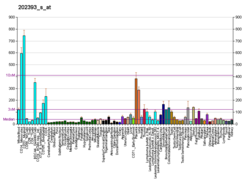KLF10

Krueppel-like factor 10 is a protein that in humans is encoded by the KLF10 gene.[5][6][7]
See also
[edit]References
[edit]- ^ a b c GRCh38: Ensembl release 89: ENSG00000155090 – Ensembl, May 2017
- ^ a b c GRCm38: Ensembl release 89: ENSMUSG00000037465 – Ensembl, May 2017
- ^ "Human PubMed Reference:". National Center for Biotechnology Information, U.S. National Library of Medicine.
- ^ "Mouse PubMed Reference:". National Center for Biotechnology Information, U.S. National Library of Medicine.
- ^ Blok LJ, Grossmann ME, Perry JE, Tindall DJ (Mar 1996). "Characterization of an early growth response gene, which encodes a zinc finger transcription factor, potentially involved in cell cycle regulation". Mol Endocrinol. 9 (11): 1610–20. doi:10.1210/mend.9.11.8584037. PMID 8584037. S2CID 22515863.
- ^ Fautsch MP, Vrabel A, Subramaniam M, Hefferen TE, Spelsberg TC, Wieben ED (Oct 1998). "TGFbeta-inducible early gene (TIEG) also codes for early growth response alpha (EGRalpha): evidence of multiple transcripts from alternate promoters". Genomics. 51 (3): 408–16. doi:10.1006/geno.1998.5388. PMID 9721211.
- ^ "Entrez Gene: KLF10 Kruppel-like factor 10".
Further reading
[edit]- Subramaniam M, Harris SA, Oursler MJ, et al. (1996). "Identification of a novel TGF-beta-regulated gene encoding a putative zinc finger protein in human osteoblasts". Nucleic Acids Res. 23 (23): 4907–12. doi:10.1093/nar/23.23.4907. PMC 307482. PMID 8532536.
- Tachibana I, Imoto M, Adjei PN, et al. (1997). "Overexpression of the TGFbeta-regulated zinc finger encoding gene, TIEG, induces apoptosis in pancreatic epithelial cells". J. Clin. Invest. 99 (10): 2365–74. doi:10.1172/JCI119418. PMC 508075. PMID 9153278.
- Subramaniam M, Hefferan TE, Tau K, et al. (1998). "Tissue, cell type, and breast cancer stage-specific expression of a TGF-beta inducible early transcription factor gene". J. Cell. Biochem. 68 (2): 226–36. doi:10.1002/(SICI)1097-4644(19980201)68:2<226::AID-JCB9>3.0.CO;2-X. PMID 9443078. S2CID 35735351.
- Cook T, Gebelein B, Mesa K, et al. (1998). "Molecular cloning and characterization of TIEG2 reveals a new subfamily of transforming growth factor-beta-inducible Sp1-like zinc finger-encoding genes involved in the regulation of cell growth". J. Biol. Chem. 273 (40): 25929–36. doi:10.1074/jbc.273.40.25929. PMID 9748269.
- Hefferan TE, Reinholz GG, Rickard DJ, et al. (2000). "Overexpression of a nuclear protein, TIEG, mimics transforming growth factor-beta action in human osteoblast cells". J. Biol. Chem. 275 (27): 20255–9. doi:10.1074/jbc.C000135200. PMID 10816551.
- Gunther M, Laithier M, Brison O (2000). "A set of proteins interacting with transcription factor Sp1 identified in a two-hybrid screening". Mol. Cell. Biochem. 210 (1–2): 131–42. doi:10.1023/A:1007177623283. PMID 10976766. S2CID 1339642.
- Antonello D, Moore PS, Zamboni G, et al. (2002). "Absence of mutations in the transforming growth factor-beta inducible early gene 1, TIEG1, in pancreatic cancer". Cancer Lett. 183 (2): 179–83. doi:10.1016/S0304-3835(01)00802-3. PMID 12065093.
- Johnsen SA, Subramaniam M, Monroe DG, et al. (2002). "Modulation of transforming growth factor beta (TGFbeta)/Smad transcriptional responses through targeted degradation of TGFbeta-inducible early gene-1 by human seven in absentia homologue". J. Biol. Chem. 277 (34): 30754–9. doi:10.1074/jbc.M204812200. PMID 12072443.
- Johnsen SA, Subramaniam M, Janknecht R, Spelsberg TC (2002). "TGFbeta inducible early gene enhances TGFbeta/Smad-dependent transcriptional responses". Oncogene. 21 (37): 5783–90. doi:10.1038/sj.onc.1205681. PMID 12173049. S2CID 6218804.
- Strausberg RL, Feingold EA, Grouse LH, et al. (2003). "Generation and initial analysis of more than 15,000 full-length human and mouse cDNA sequences". Proc. Natl. Acad. Sci. U.S.A. 99 (26): 16899–903. Bibcode:2002PNAS...9916899M. doi:10.1073/pnas.242603899. PMC 139241. PMID 12477932.
- Chrisman HR, Tindall DJ (2003). "Identification and characterization of a consensus DNA binding element for the zinc finger transcription factor TIEG/EGRalpha". DNA Cell Biol. 22 (3): 187–99. doi:10.1089/104454903321655819. PMID 12804117.
- Noti JD, Johnson AK, Dillon JD (2004). "The zinc finger transcription factor transforming growth factor beta-inducible early gene-1 confers myeloid-specific activation of the leukocyte integrin CD11d promoter". J. Biol. Chem. 279 (26): 26948–58. doi:10.1074/jbc.M310634200. PMID 15087465.
- Reinholz MM, An MW, Johnsen SA, et al. (2004). "Differential gene expression of TGF beta inducible early gene (TIEG), Smad7, Smad2 and Bard1 in normal and malignant breast tissue". Breast Cancer Res. Treat. 86 (1): 75–88. doi:10.1023/B:BREA.0000032926.74216.7d. PMID 15218362. S2CID 25869980.
- Johnsen SA, Subramaniam M, Effenberger KE, Spelsberg TC (2004). "The TGFβ Inducible Early Gene Plays a Central Role in the Anti-Proliferative Response to TGFβ". Signal Transduction. 4 (1–2): 29–35. doi:10.1002/sita.200400032.
- Gerhard DS, Wagner L, Feingold EA, et al. (2004). "The status, quality, and expansion of the NIH full-length cDNA project: the Mammalian Gene Collection (MGC)". Genome Res. 14 (10B): 2121–7. doi:10.1101/gr.2596504. PMC 528928. PMID 15489334.
- Subramaniam M, Gorny G, Johnsen SA, Monroe DG, Evans GL, Fraser DG, Rickard DJ, Rasmussen K, van Deursen JM, Turner RT, Oursler MJ, Spelsberg TC (2005). "TIEG1 Null Mouse-Derived Osteoblasts Are Defective in Mineralization and in Support of Osteoclast Differentiation In Vitro". Mol. Cell. Biol. 25 (3): 1191–1199. doi:10.1128/MCB.25.3.1191-1199.2005. PMC 543998. PMID 15657444.
- Beausoleil SA, Villén J, Gerber SA, et al. (2006). "A probability-based approach for high-throughput protein phosphorylation analysis and site localization". Nat. Biotechnol. 24 (10): 1285–92. doi:10.1038/nbt1240. PMID 16964243. S2CID 14294292.
- Fueki N, Sagara H, Akimoto K, et al. (2007). "Interleukin-10 regulates transforming growth factor-beta signaling in cultured human bronchial epithelial cells". Respiration; International Review of Thoracic Diseases. 74 (4): 454–9. doi:10.1159/000101057. PMID 17377371. S2CID 20399180.
- Jin W, Di G, Li J, et al. (2007). "TIEG1 induces apoptosis through mitochondrial apoptotic pathway and promotes apoptosis induced by homoharringtonine and velcade". FEBS Lett. 581 (20): 3826–32. doi:10.1016/j.febslet.2007.07.008. PMID 17659279. S2CID 20445009.
- Subramaniam M, Hawse JR, Johnsen SA, Spelsberg TC (2007). "TIEG1: An Important Regulator of Multiple Biological Processes and Disease States". J. Cell. Biochem. 102 (3): 539–548. doi:10.1002/jcb.21492. PMID 17729309. S2CID 42592049.
External links
[edit]- KLF10+protein,+human at the U.S. National Library of Medicine Medical Subject Headings (MeSH)
This article incorporates text from the United States National Library of Medicine, which is in the public domain.




